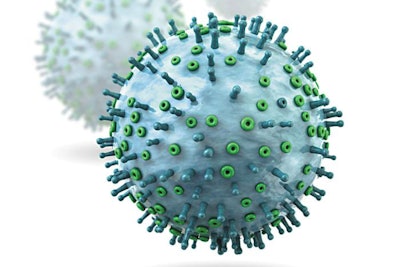
Researchers have identified feed additives that may stop the spread of viral diseases in pigs.
A study conducted by Pipestone Applied Research with a Foundation for Food and Agriculture Research (FFAR) grant tested commercially available animal feed additives to discover whether they could stop the spread of three deadly pig diseases: porcine reproductive and respiratory syndrome (PRRS), porcine epidemic diarrhea (PED) virus and Seneca Valley A (SVA). The study confirmed that these three diseases can be spread through animal feed.
The study tested whether specific feed additives, or mitigants, can deactivate the viruses and reduce the spread of disease. Researchers introduced the three viruses into animal feed and then individually added the mitigants to the contaminated animal feed. The research team then tested the pigs at Day 6 and Day 15 for the presence of the three viruses and evaluated the animals for signs of disease. Despite the presence of PRRS, PED and SVA viruses in the feed, the mitigants protected almost all animals from becoming positive for infection by the three viruses and significantly reduced the number of animals that developed signs of disease.
“Pigs that were eating feed with the mitigants outperformed the pigs that were eating the non-mitigated feed,” said Scott Dee, director of research at Pipestone Veterinary Services. “All groups were challenged with virus in the feed and the mitigants seemed to control the effects of the viruses a lot better than the non-mitigated feed, so the pigs grew faster, had less diseases, there was less virus present in their pens and in their bodies versus the control group. There were lots of metrics that suggested that mitigated feed had a positive effect.”
According to Timothy Kurt, scientific program director at FFAR, the feed additives – all of which are commercially available – that successfully stopped the spread of the viruses in feed were:
- DaaFITS: A medium-chain fatty acid blend (dry form) at two different inclusion rates (0.5% and 0.35% per ton. This product was provided by ADM.
- NuScience: A medium-chain fatty acid blend (liquid form) at 0.5% per ton. This product was provided by Purina.
- SalCURB K2: An organic acid blend at 0.275% per ton. This product was provided by Kemin.
- FINIO: A mix of acids and aldehydes (non-formaldehyde-based) at 0.2% per ton. This product was provided by Anitox.
The companies that provided the products for testing also contributed to funding the study, Dee said.
“There have been some preliminary data showing that products with certain types of chemistries may have some anti-viral effects although it’s not on their label,” he said. “But we’re looking for novel approaches and they were willing to contribute funds and products to our study.”
Can these products stop the spread of ASF?
A second phase of the study to be conducted this year will test additional mitigants and identify which ones could potentially deactivate the African swine fever (ASF) virus in feed.
Some products “could have a similar effect on reducing the potential for the transfer of African swine fever,” Kurt said. “Here, they saw that a number of these dramatically reduced the presence of the (other) virus and the transmission of the virus through feed.”
Dee is hopeful that his team can identify the mitigants that can prevent the spread of ASF very soon.
“We really hope to solve this problem with science by the end of the year,” he said.
View our continuing coverage of the African swine fever outbreak.
















